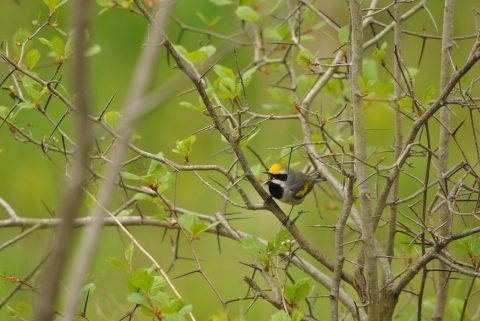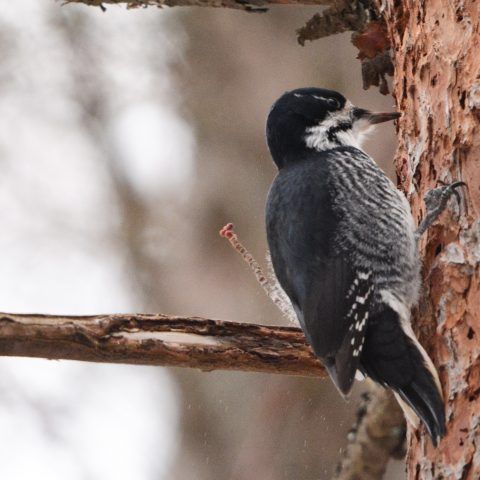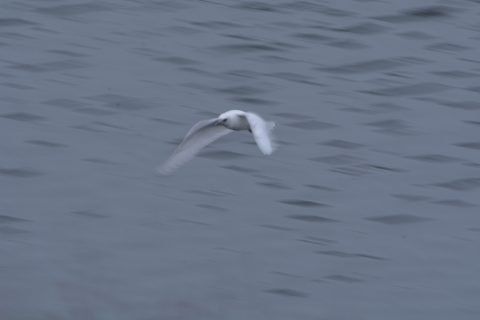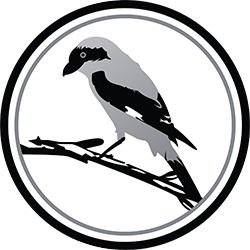BLOG
Trip Reports

6 March 2020
At the beginning of a new year, it’s nice to reflect back on the best birds of the previous one and look forward to the birds we hope to see in the new year. Last year was a fantastic year for rare birds in Muskoka and because I was doing a Muskoka Big Year, I managed to see a lot of them. I saw 212 species in Muskoka last year, which was above 90% of the birds seen last year. Below are a list of my top 10 birds of 2019, in no particular order. 10. Eastern Screech-Owl Before 2019, the last time a screech owl had been seen in Muskoka was back in 2014. I had counted this among birds I would see, but in May I was headed to bed and letting my dog back in the house when I heard a monotonic trill in my backyard. I do amphibian surveys, so I knew it wasn’t a frog which left the only other possibility being an owl. And it was an owl I hadn’t seen yet that year, as I struggled to recognize the call. Thirty minutes of checking audio recordings and listening to the bird allowed me to definitively ID it as an Eastern Screech-Owl, this first record in Muskoka in about 5 years. I texted all the other birders in the area, but seeing as it was already 11:30 pm, no one could come. I went to sleep listening to the trill of the owl and it wasn’t heard again until December. (And then it called for six hours straight, two nights in a row, so other birders managed to get it.) 9. Great Horned Owl On two separate occasions I managed to find a Great Horned Owl in Muskoka, once heard and once seen. The first instance was originally reported by Janice House and it was about 2 hours that we needed to wait before we found it again. It was early April that it was seen and the lighting was fantastic for viewing. It stuck around in the same area for another couple hours before flushing and flying further down the river. My second record was a Great Horned Owl heard at the last stop of our Nocturnal Owl Survey. Another April bird and hooting very softly in the distance. It was a great finish to an owl route that had numerous Barred Owls as well. 8. Black-backed Woodpecker Every bird after you hit 200 species in Muskoka is a rare one and the Black-backed Woodpecker was no exception. It was reported over Christmas, and since I was with family, I had to wait three days before trying to see it. The first trip had no luck, with two hours of searching turning up nothing. An early drive the next morning did produce a lovely male Black-backed Woodpecker, a different individual than previously reported. This bird was my 212th species that year for Muskoka and my last new species of the year. Stunning views from under 10 feet away made it an incredible last bird for my checklist. 7. Ross’s Goose The second ever report of a Ross’s Goose was almost an hour away, but that time seemed much longer on the drive there. It had been showing up regularly at a golf course and was spotted that day. I left as quickly as possible, but the drive appeared agonizingly slow, especially when I had to stop for gas along the way. Luckily, the bird was still around when I got there and was peacefully grazing on grass with no apparent worries. A hundred photos later and after a discussion with some experts, it was confirmed for sure as a Ross’s Goose and a welcome addition to my list of birds for the year. 6. Black-crowned Night-Heron Georgian Bay is an incredible spot for rarity and this bird was no exception. We were out for a paddle at our cottage and had made it to a large open water marsh. Earlier that day, I had joked about seeing a Black-crowned Night-Heron and lo and behold, as soon as we entered the marsh I saw one flush from the reeds. There was no time to take a photo or appreciate the bird with how quickly it flew away. Luckily, when we returned two weeks later, the bird was still around and gave us much better views before flying out of sight. 5. Golden-winged Warbler Another Georgian Bay bird, but one that was a bit more inland. Another birder had reported a Blue-winged Warbler and a Golden-winged Warbler down near Honey Harbour and I resolved to wake up at 4 am and drive there before work to check it out. The first thing I heard as I arrived and rolled down my window was a Blue-winged Warbler. I found the Golden-winged Warbler a short period later, singing it’s traditional song. Despite being a rarer bird, the Blue-winged Warbler doesn’t appear on this list for a reason. When I first heard the Golden-winged Warbler, it was calling on the left hand side of the road and the Blue-winged Warbler was calling on the right. When I looked to the right, I only managed to see a Golden-winged Warbler, which was odd because I was also seeing a Golden-winged Warbler to the left. In total, I spent about two hours recording, videoing, and watching this birds and realized it was a pair of Golden-winged Warblers, one of which was calling exactly like a Blue-winged Warbler. A very good experience in dealing with birds that have a history of hybridizing. 4. Red-bellied Woodpecker This bird was one of the few I had to stakeout for a long time. In February, a pair of volunteers came to the Muskoka Conservancy office and mentioned a Red-bellied Woodpecker coming regularly to their feeders. They kindly offered to let me come to their house and wait for the bird to show up. So I did. And I waited for two hours in their house before the bird showed for all of two minutes. They were gracious and offered my coffee and tea while I waited in their living room for a single bird. I’m not sure if they thought I was crazy or not, but they seemed to understand how important it was. It ended up being a really fun stakeout all things considered and I got some very nice photos and views of the bird before it disappeared. 3. Bohemian Waxwing Bohemian Waxwings are not unusual birds for Muskoka, but mine were a bit unusual. I had tried multiple times throughout the year to find a roving Bohemian Waxwing flock and every time I turned up empty. People would report them a day before or a day after I found them, but I could never find them myself. I had given up in late April because most of the flocks had already moved northward, but it seems the birds were destined to find me, instead of me finding them. On May 5th, a pair popped up while I was walking Coopers Falls Trail and I was lucky enough to get photos of them or I would have written them off as Cedar Waxwings, thinking it too late for them to show up. But birds have a habit of appearing when you least expect them, so I learned quite quickly to inspect everything you see thoroughly so as to not overlook any unusual birds. 2. Great Egret Two Great Egrets appeared in Muskoka in 2019, one in spring and one in fall. I caught the fall one, mainly due to a lucky post around Easter. We were driving back from our family’s Easter Gathering on April 21st and I just so happened to get an email about a Great Egret sighted on our way home. With a little convincing of my parents, we made a short detour to view the bird. I sent out a text to the other birders, none of who had received the post yet and because of the distance we needed to drive, they beat me to the bird. It hung around until I arrived 10 minutes later and we had some stunning views of a gorgeous bird. It was very unconcerned about the nearby road and birders and we got to see it catch prey and show off it’s magnificent plumage. 1. Gray Island Birds Gray Island is a small island off the coast of Georgian Bay and an absolute gem. I found so many birds here that it’s easier to lump them all together, as I’d have close to 10 just off this list. We didn’t start visiting this island until late July, so we missed all of spring migration, but fall migration definitely made up for it. The first visit there pulled out both a breeding plumage Bonaparte’s Gull and a pair of Sanderlings. Sanderlings are unusual for Muskoka and most of the past records were found out in Georgian Bay. In fact, we probably recorded more Sanderling sightings here this year than we have in the past historical records. Sanderlings were seen at Gray Island until October, which is an incredibly long time to see such an unusual bird for Muskoka. Our next outing yielded both a single Black-bellied Plover and a Ruddy Turnstone, again unusual birds for Muskoka. A little later in the year, we brought out a couple more birds and pulled a group of Semi-palmated Plovers, a Prairie Warbler, and a Peregrine Falcon off the rock, with a record number of Sanderlings as well. A few days later, a Baird’s Sandpiper showed up on our almost daily survey of the rock. Finally, we got a count of 60+ American Pipits among the various rocks around Gray, ending the year in a spectacular fashion. This island is one such a productive birding spot and very tough to access if you don’t cottage nearby. Luckily, our family cottage is within about a 15 minute boat ride, so I’m already dreaming about what I’ll find on spring migration this year.

16 January 2020
Some of these birds will be repeats from the birds previously mentioned in Muskoka’s Top 10 published earlier today, while others will be birds that I have added to my personal list that I did not think had as big an impact to the overall birding of the county. Birds included in this top 10 could be deemed important for several factors. Self-found rarities, life birds and birds that I feel I “worked” hard for are all among this list. Although I narrowed down the list to a short 10, there are several birds I feel deserve a mention as they elicit excitement as I look back to them and think about the people I shared the memories with. Note Worthy Birds: Barrow’s Goldeneye, Great Horned Owl, Ring-necked Pheasant, Sedge Wren and Red-headed Woodpecker. All of these birds happened to be lifers in Muskoka over the course of 2019, however all were expected at some point if one birds long enough. Now on to the short list. 10. Golden-winged Warbler- This bird had been on my radar for a while and was a bird I knew I would run into at some point in 2019. All my favourite birding sites contain habitat that are just prime to have Golden-wing on occasion however after striking out several times in May, I would take any chance I could get. When one was reported near Baxter Sewage Lagoons in late May I decided I would chase it as an early birthday present to myself. Thus on May 29th, I saw my first Golden-winged Warbler in Muskoka and my third in the province that month. This marked my 209th bird in Muskoka!

16 January 2020
I am using this as an exercise to both relive some of my favourite memories of the year 2019 but also to practice writing so that I can grow as a writer. As the year comes to a close we see top’s/rankings everywhere. Instagram has its top nine. We also see Instagram stories full of top tracks from Spotify, sports channels have plays of the year and as birdwatchers many of us have top 10 birds, places and experiences. The following will be my personal Top 10 Birds seen in Muskoka (which I consider my county), Ontario and my personal Top 10 birds in both Ontario and Muskoka. Originally I had planned on making this one post but after seeing how long it is going to be I have decided to split it into several. Muskoka’s Top 10 Below are a list of what I have considered the cumulative Top 10 birds species seen in Muskoka through the 2019 calendar year. Honourable mentions go to Great Egret with two records in Muskoka this year and Great Gray Owl as both species put on a great show, to the delight of both birders and non-birders alike. 10. Wilson’s Phalarope – This bird was a one day wonder, showing up on August 21 at the Bracebridge Sewage Lagoons. Originally seen by David and Regan Goodyear around 6:30 pm. The word quickly went out and several people got to see it, including myself. Many searched however the bird was not seen in subsequent days. On this occasion I would learn a valuable lesson; never leave your memory card in your laptop. The previous night I was going through some pictures before bed. With the fading daylight when the bird was reported, I jumped up from the table and grabbed my camera, only to realize upon trying to take a photo that my memory card was still sitting at home. Thankfully there is digiscoping.
SHRIKE BIRDING
© 2025
Copyright Shrike Birding
Site Designed & Developed by Client First Web Design & Graphics
